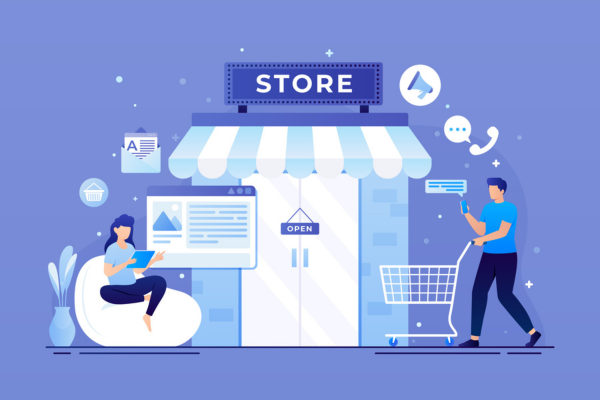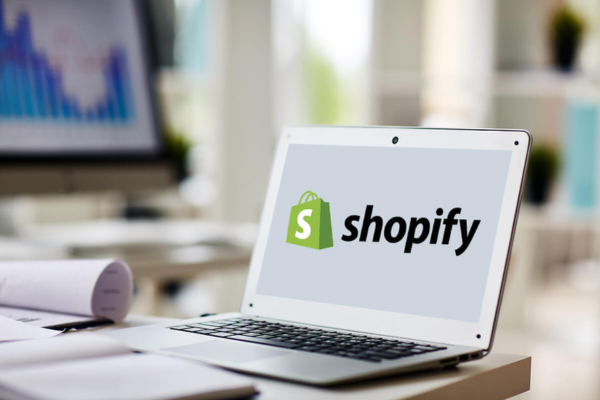
How to Start an eCommerce Business: 2025 Edition
2.71 billion people shop online, which makes up 34% of the global population. This figure is expected to go up by 2025. The main reason for this rise is mobile commerce. In 2023, it was responsible for $2.2 trillion in sales. These highlighted figures show that now is the best time to start an e-commerce business, especially in the United States. Why in the United States? The U.S., along with China, is one of the largest markets for online shopping. This has pushed global e-commerce sales to $5.8 trillion in 2023. The interesting part is that this number is expected to keep growing.
This may be a difficult task if you are new to online commerce, as you may not know where to begin. Should you start by focusing on designing your website, choosing the right products to sell, or should you concentrate on marketing? These are common questions that many new entrepreneurs face.
Find answers to these questions and more. We will also provide a step-by-step guide on how to start your online store in 2024 and show you how to set up, manage, and grow your business into a profitable e-commerce venture.
Start an E-commerce Business in 7 Steps
We will explain how to start an e-commerce business in seven straightforward steps, so take your time and follow along. You’ll have a good idea of what to do by the end.
1. Find Products to Sell
The product you choose to sell, among other things, will make or break your online store. You have to be strategic when choosing your product(s). We have compiled a few tips on finding the right product for your online store.
- Capitalize on regional products.
The market is a bit saturated, but there’s still room for you if you are tactical. Instead of selling generic products, you can stand out by offering products unique to certain regions or cultures. These can be traditional crafts, local delicacies, or specific fashion styles. This way, you will be known for a specific type of product and will be sought after.
- Explore niche communities
You can also look into niche hobbies or communities catering to specific groups. These communities usually have enthusiastic members always looking for particular, sometimes hard-to-find, items. It’s quite possible that you could come across something really special if you take the time to search. It might be worth it to just look and see what’s out there.
- Solve a pain point
One simple way to find a product is to draw from your own experiences. Think about a problem you’ve faced and consider whether there’s something that could fix it. If you can come up with a product that solves a real issue, others will likely find it helpful, too. Products that solve real problems tend to connect well with people.
Your search doesn’t end in these three tips. You’ll find inspiration is abundant once you start your search. Google Trends, a tool that helps you explore trends or what people are searching for, can be a helpful tool to validate your product ideas.
2. Source your Products

Once you’ve decided on what you want to sell, the next thing to do is to think about how to get your hands on the product. This can be challenging, but in cases like this, one way to make things easier is by dropshipping. You don’t keep an inventory of your products with the dropshipping model. Instead, when someone buys something from your store, you order that item from a supplier, like a manufacturer or wholesaler. They then send the product directly to your customer.
Even though dropshipping seems like a solid plan, it may not work in all situations. other business models, like wholesaling or direct-to-consumer, might suit different business needs. However, dropshipping stands out for several reasons:
- Testing new ideas is easier: You can experiment with multiple products with dropshipping. You don’t need to stock products that may not do well in sales. You pay for each sale you make; if zero sales are made, zero risks are taken.
- Geographic flexibility: You can run the business from anywhere as long as you have internet access. Send the product from the supplier to the customer from anywhere.
- Lower entry barriers: You don’t need a huge budget to start dropshipping. Each sale is working capital. You take your profit and pay the supplier the initial price to send the product to the customer.
3. Study your Competitors

It is not a good idea to start your online store blindly. You need to do ample research. It is integral to the success of your online store. The first point of research after deciding on your product is your potential competitors. These businesses are already operating in the market, so you can pick up a lot of useful information by studying them carefully. You’ll be able to see what strategies are working for them and what might not.
When you’re analyzing your competitors, there are several aspects you should focus on:
- What kind of business model do they use?
- Are they offering a range of products, or are they focusing on just one?
- Which social media platforms are they active on?
- Who exactly are they trying to reach with their marketing?
- What methods do they use to boost their sales? Do they rely on paid social media advertising, pay-per-click ads, search engine optimization, email marketing, or something else?
Competitor analysis can help you identify better products to sell and give you a good understanding of how to launch an online business.
4. Write a business plan

A business plan outlines everything about your business, how you plan to make money, who to target as customers and more. Internally, it gives you a clearer picture of what you want to achieve and how to go about it. It also helps you organize how you run your business. Developing a business plan will guide e-commerce from start to growth. Here’s how you can write a business plan:
- Set clear objectives: You need to set measurable goals for your business. These goals could include sales targets, customer acquisition numbers, or market penetration rates. These goals will help you realign yourself when you seem to be drifting off course.
- Describe your business model: How would you manage your inventory? Would it be through dropshipping or stocking?
- Plan your marketing: Brainstorm how you will attract customers. Include tactics like SEO, social media marketing, and influencer collaborations.
- Make financial projections: Include detailed financial forecasts. Show expected revenue, expenses, and break-even points.
- Conduct a risk analysis: Identify potential challenges and consider how you’ll address them if they happen.
- Create an action plan: Break down your strategies into smaller chunks with deadlines to make your goals achievable. This should help you track your progress as you move forward.
5. Choose a name
You may not have expected naming your business as part of the plan, but it is crucial. This step is critical because a good name sticks in people’s minds and becomes synonymous with your brand’s identity. In 1996, Larry Page and Sergey Brin called their initial search engine BackRub before landing on “Google” by accident. Imagine saying, “I need to BackRub this word.” See? This is why even though naming a business may seem trivial, it carries much weight. Choose a memorable, catchy brand name that evokes the correct associations to help it stick but is also marketable. For example, names like ‘Zappos,’ ‘Yahoo,’ and ‘Google’ are in a way “meaningless” but catchy. While choosing your name, here are a few boxes it should tick.
- It should be search engine-friendly.
- It shouldn’t be similar to a competitor’s name.
- It shouldn’t be hard to pronounce.
- Check if a domain is up for grabs.
Brainstorm possible business names. Familiarize yourself with how competitors in your field came up with their brand names. See if there are any patterns or common practices in your industry regarding naming.
Think about household name brands you recognize the most. For example, when you hear the name Kleenex, what do you think of? Or what about Sharpie? It’s important to spend time thinking and trying out different ideas to find the perfect name for your brand.
6. Build your online store

Now comes the important part—getting started on creating your online store. There are quite a few different ways you can approach this, so it’s worth taking some time to consider all the options available to you. It’s not something you want to rush into because there are various factors to think about. From choosing the right platform to figuring out the design and layout, each step plays a crucial role.
- Build it from scratch.
If you are technical, you can build your e-commerce site to your exact specifications. However, if you’re unfamiliar with these technical aspects, there’s no need to worry. You can always bring in an engineer with the skills to do this for you. This engineer can help set up your website, ensuring that the shopping cart and payment page work smoothly with the payment processor, making the online shopping experience seamless for your customers.
Building your own e-commerce site comes with some good points.
- One of the main benefits is that you have much control over how the website looks and works.
- You can design it just as you want, with very few limits.
- Also, if you use a third-party hosting company, the only regular cost you have is the hosting fee, and there aren’t any extra monthly fees.
However, there are also some challenges.
- You will likely need a web engineer to help you with updates or changes, like adding new products or adjusting prices. This means you will have to pay the programmer whenever you need their help, which can add up over time.
- Additionally, getting people to visit your website can be tough and requires some effort.
- Build your online store with WordPress.
If you are tech-savvy but not a programmer, you can build a highly customized online store with WordPress. WordPress has a “what you see is what you get” interface, meaning you can design and add content without any programming expertise.
If you’re willing to do some initial extra work, you can create a unique and compelling online store with WordPress that is easy to update and inexpensive to maintain.
Some advantages of WordPress are:
- E-commerce themes are built in.
- WordPress has a built-in content management system, which makes it easy to change or update your products, pricing, and content.
- With WordPress plug-ins, you can add almost any function to your site, including a shopping cart and other e-commerce features.
- WordPress offers excellent SEO capabilities.
- You can concurrently run an affiliate program with WordPress, unlike with e-commerce platforms.
Some drawbacks:
- WordPress can be quite a challenge to build on your own. You will need some bit of experience in this domain.
- You have to set up hosting and a custom domain for yourself. While not too difficult, it’s more of a process than with a self-hosted website builder.
- E-commerce functionality comes via plug-ins ― it is not built into WordPress. Although most e-commerce plug-ins are very well integrated, it’s still another step to figure out.
- Build with a dedicated e-commerce platform.
If online sales will be the primary focus of your business, a dedicated e-commerce platform may be a good choice too. These online store providers are about sales; their features and services reflect that focus. Some of the most recommended ones are:
- Shopify

Shopify is a platform for creating and managing an online store. When you set up your store with Shopify, everything is ready to go, including payment processing and inventory management. You can start selling online with customizable templates, easy-to-use tools, and features like shipping, taxes, and marketing, making it ideal for people who are not tech-savvy. It’s popular among small businesses and entrepreneurs because it’s user-friendly and can scale with your business. It doesn’t come free, though.
- Basic: $24 per month (billed annually)
- Shopify: $69 per month (billed annually)
- Advanced: $299 per month (billed annually)
- Plus: $2,300 per month (billed annually)
There is no transaction fee if you use Shopify Payments. Otherwise, third-party transaction fees cost between .6 percent and 2 percent per transaction.
- BigCommerce
BigCommerce is another platform similar to Shopify that helps people create and run online stores. It’s designed to help businesses of all sizes sell products online, whether starting out or already established. With BigCommerce, you can manage inventory, process payments, and handle shipping.
BigCommerce has four pricing plans:
- Standard: $29 per month (billed annually)
- Plus: $79 per month (billed annually)
- Pro: $299 per month (billed annually)
- Enterprise: Custom pricing
- ShopWired
Like Shopify and BigCommerce, ShopWired provides the tools to build your store, add products, process payments, and manage orders. ShopWired is particularly popular in the UK and is known for being user-friendly and affordable.
What sets ShopWired apart is its focus on offering many features without requiring additional apps or plugins. This makes it a good choice for those who want a simple, all-in-one solution. It includes customizable templates, SEO tools, and options for multi-channel selling, allowing you to sell on platforms like eBay and Amazon directly from your store.
ShopWired has four plans, none of which charge transaction fees:
- Pro: $23.96 per month (billed annually)
- Advanced: $47.96 per month (billed annually)
- Premium: $95.96 per month (billed annually)
- ShopWired Enterprise: From $249.95 per month (billed monthly)
- Set up shop in an online marketplace.
An online marketplace is an eCommerce website where multiple sellers can list and sell their products or services to customers. Instead of just one store, like a typical online shop, an online marketplace hosts many different sellers.
Examples of popular online marketplaces include Amazon, eBay, Etsy, Alibaba, and Facebook marketplace. These platforms allow individual sellers, businesses, or even large retailers to create accounts and list their products for sale. Customers can browse various items from different sellers, compare prices, and purchase all in one place.
The marketplace operator usually handles the technical aspects, like website maintenance, payment processing, and sometimes even shipping, while the sellers focus on their products. Online marketplaces are convenient for shoppers because they offer a broad selection of products from various sellers, and they can often find better prices or unique items that aren’t available in traditional stores.
6. Choose your sales and marketing channels
There are different sales channels available, and choosing the right ones depends on your target audience and the products you sell. For example, if you sell unique or handmade items, a marketplace like Etsy is better suited for you than larger platforms like Amazon or eBay.
Here’s a list of marketplaces for different niches:
- Bonanza: Ideal for selling unique and diverse items like trendy clothes or rare collectibles.
- Newegg: Best for electronics and tech gadgets.
- Reverb: Focuses on musical instruments and gear, connecting you with musicians and enthusiasts.
Regarding marketing, it’s important to balance cost and effectiveness. Here are some strategies:

- Social media marketing: Engage with your audience on platforms like Instagram to showcase your brand affordably.
- Email marketing: Use interactive emails with quizzes or polls to boost engagement and gain insights without spending much.
- Influencer partnerships: Collaborate with niche micro-influencers who can effectively target specific customer groups at a lower cost.
- Search engine optimization (SEO): Focus on optimizing for voice search, a smart strategy that can save money in the long run.
7. Launch your business
Now that you’re ready to sell products, there are a few important things to remember.
First, closely monitor your key performance indicators (KPIs). They show how well your store is doing and highlight areas needing improvement.
Next, ensure smooth shipping. Satisfied customers are more likely to return, so delivering orders on time is essential. Have a backup plan in case something goes wrong.
Lastly, keep learning and adapting based on customer feedback and data. This will help your business grow and improve over time.
Final Words
Starting an online e-commerce store is thrilling and demanding, often requiring you to juggle multiple roles. To streamline this process and ensure success, consider partnering with professionals like AeroForged. Our digital engineering services and marketing strategies are designed to guide you every step of the way. Take advantage of our free consultations and resources, which offer comprehensive solutions tailored to your needs.
Embark on your e-commerce journey with us today and stay ahead of the industry’s latest trends!
